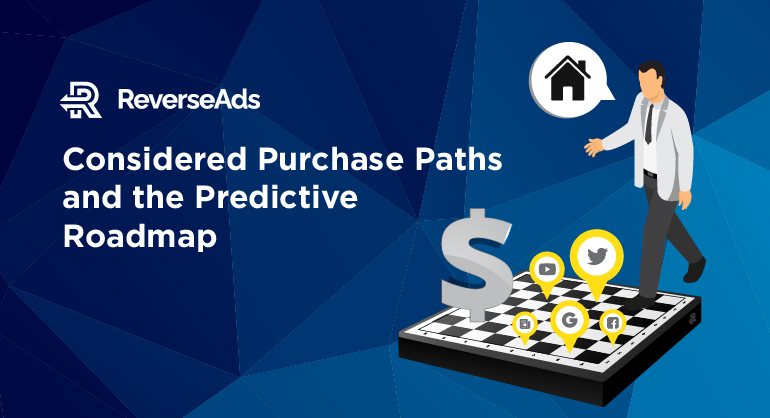Considered Purchase Paths and the Predictive Roadmap

As we speak, advertising is being transformed by A.I. and machine learning technologies. While past performance data informed old marketing strategies, purchase paths can now be predicted. This means that media buying strategies can be optimized to meet consumers where they are going throughout the entirety of the buyer’s journey instead of making adjustments by analyzing where they have been.
Businesses that are already starting to drive results through predictive road-mapping are most commonly operating in considered purchase paths (CPP). This is because considered purchase path buyers are spending an average of 79 days researching before arriving at a decision. All of this time spent researching products results in the generation of incredible amounts of data. This data is then used to fuel predictive algorithms and optimize ad campaigns.

How are CPP businesses assembling predictive roadmaps?
The legal industry is extremely competitive, and services in this vertical come at a high price. This results in some of Google’s most expensive CPC. Keywords at the top of the list include:
At the foundation of all predictive roadmaps lives predictive analytics. While predictive analytics can be applied to a variety of marketing-related solutions, it is arguably most valuable in the context of predictive advertising. Businesses can utilize predictive analytics within their advertising strategies to analyze the data generated by consumer behavior. This data then helps illuminate the predictive roadmap that is being followed on the considered path to purchase.
All of this data generated can be quite daunting, as a majority of it is unstructured. Unstructured data is difficult to collect, analyze, and store. However, these processes are becoming easier to carry out through the help of A.I. technology. When compiled, all of this unstructured data holds the potential to improve advertising strategies and generate a much more accurate predictive roadmap.
Keyword data is a critical component of predictive roadmaps. Keywords offer focus areas so that consumers with the most purchase intent can be located and effectively advertised to. Unstructured data offers keyword insight, as you can see what keywords a consumer is using and how they are using them. This makes it possible to serve ads to a user while outside the search engine, but still using one of your specific keywords.

The combination of predictive analytics, unstructured data, and keyword selection makes it possible to uncover consumer behavior trends and predict the roadmap that they will follow on their considered path to purchase. This then makes it possible to optimize ads and serve them at pivotal moments on the buyer’s journey, which can guide a consumer into a conversion.
How are Predictive Roadmaps Optimizing The Ads Being Served?
Machine learning is improving the ads that brands are serving to their customers. The data that is collected on the buyer’s journey allows businesses to optimize copy and graphics to increase relevancy and appeal to the consumer based on their predicted location on the path to purchase.
If a consumer is in the consideration or evaluation stage of the buying process, they won’t be as receptive to ads that target consumers at the awareness stage. This ad optimization can be carried out in real-time, without the need for a deep roster of data scientists.
How Are Predictive Roadmaps Disrupting The Traditional Sales Funnel?
CPP brands have gleaned new insights through the use of predictive analytics. One of the most transformative insights has been the undeniable complexity of purchase paths and traditional sales funnels’ inaccuracy. Whether these brands provide B2B services or B2C products in considered purchase paths, they are all seeing their customers traverse non-linear paths to purchase.
It’s for this reason that many brands operating in these non-linear purchase paths are not seeing ROI on their Google Ad investments. These search ads are too linear, which reduces their scope. Google Ads are excellent at targeting the top-of-the-funnel or the early stages of a purchase path. However, they aren’t addressing the other 90% of the funnel that predictive roadmaps are illuminating.
Companies incorporating predictive roadmap strategies are gaining a previously unattainable perspective of the entire roadmap. This new information leads to the need for new advertising solutions that move beyond the traditional sales funnel. These solutions use predictive analytics to engage consumers at the most optimized moments on their non-linear buyer’s journey.
The geographic specificity of real estate advertising makes keyword selection extremely important, as businesses want to make sure that they are attracting clicks from customers interested in buying in the cities they are being listed. This is why many of the most expensive keywords in this industry contain location-specific information.
Why ReverseAds?
At ReverseAds, we are leading brands into the future of predictive advertising. Media buyers seek predictive solutions that leverage the “full” roadmap to maximize engagement and outperform traditional search in considered purchase paths. We can address this need through our assignment algorithm, which is currently pending with the USPTO. Through the power of our patent-pending algorithm, we empower brands to be everywhere after search.
From a security perspective, The ReverseAds cookieless solution protects customer privacy while meeting consumers’ demands (and behaviors) across purchase path industries who expect information and presence throughout their entire considered purchase roadmap.
If you’d like to learn how to take advantage of developments in predictive advertising, visit https://www.reverseads.com/ or email us at info@reverseads.com to schedule a time to speak with a ReverseAds Data Intelligence Specialist.





